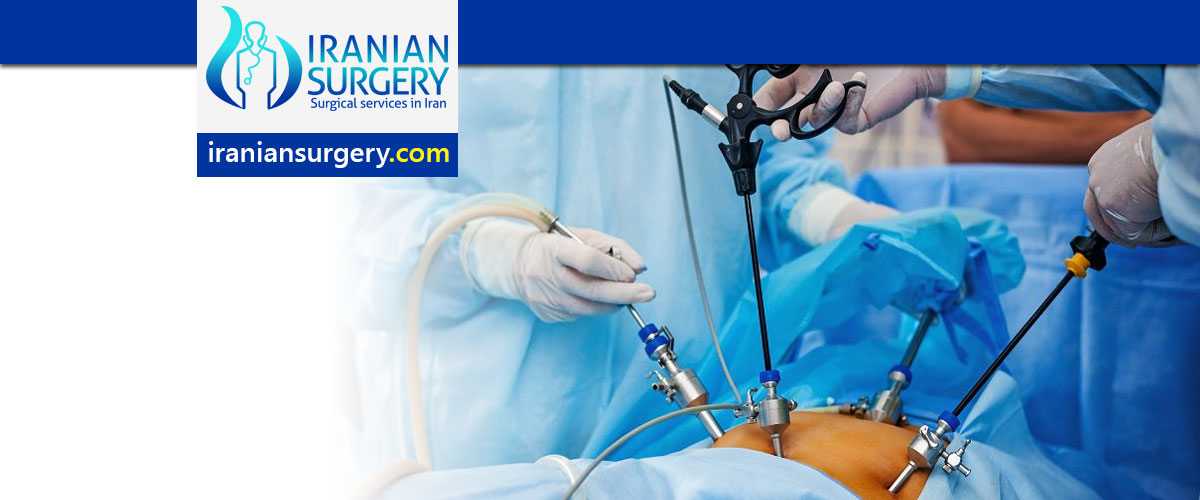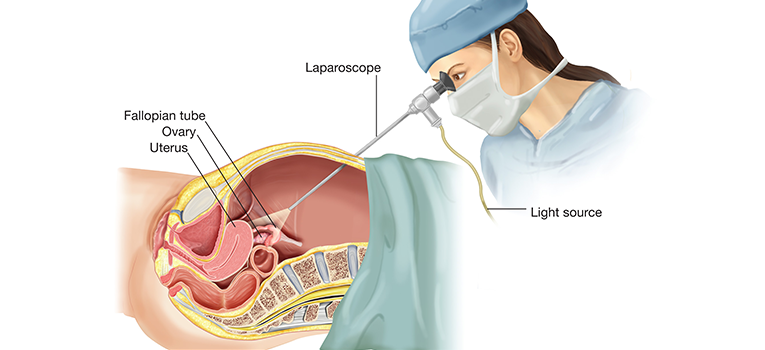Laparoscopic surgery in Iran

Laparoscopic Surgery cost Iran
Laparoscopic surgery or Laparoscopy also called minimally invasive surgery (MIS), band aid surgery, key hole surgery is a modern surgical technique in which operations in the abdomen are performed through small incisions (usually 0.5–1.5 cm) as compared to the larger incisions needed in laparotomy. It is one of the most significant advancement of Surgery which took place in the 20th century.
It has contributed greatly to the three corner stones of Modern Surgery viz. Reduction of Pain, Bleeding and Infection. Although laparoscopy has been used for many years by gynecologists to evaluate pelvic pathology, most surgeons did not recognize its value until laparoscopic gall bladder operation was done. Since that time, the application of laparoscopic instruments and techniques has greatly improved, and new uses are being developed rapidly.
What affects the final cost of Laparotomy?
- Treatment method
- Type of anesthesia or sedation
- Other treatments performed in conjunction
How much does Laparotomy in Iran?
Laparotomy cost in Iran start from $300.

Reasons for Procedure
This procedure is done to evaluate problems in the abdomen.
Problems that may need to be examined with an exploratory laparotomy include:
A hole in the bowel wall
Ectopic (outside the womb) pregnancy
Endometriosis
Appendicitis
Damage to an organ from trauma
Infection in the abdomen
Cancer
Possible Complications
Complications are rare, but no procedure is completely free of risk. If you are planning to have a laparotomy, your doctor will review a list of possible complications, which may include:
Bleeding
Infection
Blood clots
Damage to organs
Hernia formation
Large scars
Reaction to the anesthesia
Some factors that may increase the risk of complications include:
Previous abdominal surgery
Diabetes
Heart or lung disease
Weak immune system
Blood disorders
Taking certain medicines
Smoking, alcohol abuse, or drug use
Be sure to discuss these risks with your doctor before the procedure.
What to Expect
Prior to Procedure
Leading up to your procedure:
Your doctor may perform the following:
Physical exam
Blood and urine tests
Ultrasound—a test that uses sound waves to visualize the inside of the body
Computed tomography (CT) scan—a type of x-ray that uses a computer to make pictures of the inside of the body
Magnetic resonance imaging (MRI) scan—a test that uses magnetic waves to make pictures of the inside of the body
Talk to your doctor about your medicines. You may be asked to stop taking some medicines up to one week before the procedure, like:
Anti-inflammatory drugs (eg, aspirin)
Blood thinners, like clopidogrel (Plavix) or warfarin (Coumadin)
Arrange for a ride home.
The night before, eat a light meal. Unless told otherwise by your doctor, do not eat or drink anything after midnight.
What are Types of Laparoscope in Iran?
There are two types of laparoscope in iran:
1.A telescopic rod lens system, that is usually connected to a video camera (single chip or three chip),
2.A digital laparoscope where the charge-coupled device is placed at the end of the laparoscope, eliminating the rod lens system.
What Types of Procedures Performed under Laparoscopic Surgery?
Dozens of different kinds of operations are now being done using these new minimally invasive techniques. These include operations on the abdomen, heart, reproductive organs, nerves, ear, nose, sinuses, throat, joints, chest organs, urinary tract, and blood vessels. These techniques are also used in plastic and reconstructive surgery. It may be an appropriate choice for conditions and diseases such as the following:
Diseases and conditions of the abdominal organs, including:
Gallstones
Removal of a damaged or diseased spleen;
Inguinal hernia repairs, when part of the intestine bulges through a weakened segment of the abdominal wall;
Gastroesophageal reflux disease (GERD).
Some problems of the colon (large intestine) or rectum; and
Removal of an infected or inflamed appendix
Peritonitis
Appendicitis
Abscesses
Adhesions
Diverticulitis
Intestinal perforation
Ectopic pregnancy
Foreign bodies
Internal bleeding
Gynecological conditions or procedures includingGynecological conditions or procedures including:
Pelvic pain of uncertain cause;
Ovarian cysts;
Endometriosis;
Pelvic adhesions;
Ectopic pregnancy;
Infertility;
Hysterectomy; and
Tubal ligation
Treatment of torn cartilage, ligaments, joint pain, and mobility problems in:
The shoulder;
Knee;
Lower back pain caused by a herniated spinal disk ; and
Spine, such as fusing segments of the backbone together to make the spine more stable.
Correction of abnormalities in the paranasal sinuses that cause chronic sinus infections:
Sphenoidal sinus
Ethmoidal sinus
Maxillary sinus
Frontal sinus
To get free no obligation Quote For La
What are the Advantages of Laparoscopic Surgery against Open Procedure ?
There are a number of advantages to the patient with laparoscopic surgery versus an open procedure. These include:
Reduced hemorrhaging, which reduces the chance of needing a blood transfusion.
Smaller incision, which reduces pain and shortens recovery time, as well as resulting in less post-operative scarring.
Less pain, leading to less pain medication needed.
Although procedure times are usually slightly longer, hospital stay is less, and often with a same day discharge which leads to a faster return to everyday living.
Reduced exposure of internal organs to possible external contaminants thereby reduced risk of acquiring infections.
Although laparoscopy in adult age group is widely accepted, its advantages in pediatric age group are questioned. Benefits of laparoscopy appear to recede with younger age. Efficacy of laparoscopy is inferior to open surgery in certain conditions such as pyloromyotomy for infantile hypertrophic pyloric stenosis. Although laparoscopic appendectomy has lesser wound problems than open surgery, the former is associated with more intra-abdominal abscesses. While general benefits of having laparoscopy is as under:
There is no cutting of the muscles as the holes are made in between the fibers.
The pain is minimal like one would have after a skin cut.
Less chance of hospital acquired infections
Fewer post-operative chest complications
Early return to work
No residual weakness.
Minimal risk of incisional
Less disturbing to physiology.
Exploratory ' open & close ' look into the tummy operations are avoided and the same information is gained on diagnostic laparoscopy as a day case patient with one or maximum two holes.
Avoidance of large cuts and rib removals in the case of thoracoscopic surgery
In the case of diagnostic laparoscopy, quick information is gained and the entire procedure can be recorded on video and further opinion can be taken from other surgeons in case of a diagnostic dilemma.
Despite small holes, there is no compromise in the field of vision. Much more of the 'insides' can be seen than is possible at an open operation. Unlike the 'mini-incision' operations, here the entire tummy can be visualized ensuring no abnormal anatomy or pathology is missed.
What are the Preparations for Laparoscopic Surgery in iran?
Patients scheduled for laparoscopic surgery in iran usually visit the doctor's office before the operation to discuss the procedure in detail. During the visit, the doctor should fully explain the procedure, what will be done and why, the risks, and how you will benefit from the procedure. The doctor also should answer questions about the procedure. Tests may be ordered, which include blood and urine tests, an electrocardiogram, and possibly an ultrasound scan or x-ray. For further information about ultrasound, go to Ultrasound.
On The Day Of The Operation: Most laparoscopic surgery is done on an outpatient basis, but this does depend on the procedure and how well the patient is. People undergoing laparoscopy should not eat or drink anything after midnight on the night before the procedure. If medications are usually taken in the morning, check with the doctor on whether to take them with a sip of water, take without water, or skip the dose. Before the surgery, an intravenous line, which consists of a small flexible plastic tube, may be inserted into a vein in the patient's arm or hand. It is used to give medications and fluids during the operation. Sometimes intravenous medication is administered before surgery to help the patient relax.
What is the post Operative care following a Laparoscopic Surgery?
Here are few precautions you need to follow after having a laparoscopic surgery:
What is the post Operative care
Patients who have laparoscopic surgery should carefully follow their doctors' instructions after going home. The exact kind of care needed depends on the type of surgery, the individual's age and general health, and other factors. In general, people recovering from laparoscopic surgery should care for their incision as directed by the doctor, be cautious about certain activities, and watch for any of the warning signs.
Following Laparoscopic Surgery on the abdomen or pelvic areas, it is most likely that one will:
Leave the adhesive bandage or dressing on the incision for two days. During that period, keep the incision area dry. Do not take a shower.
No need to apply new bandages to the incisions unless clothing is rubbing against them.
Remove the bandages after two days, following the doctor's instructions. Individuals usually can resume taking showers at this point.
How long it takes for a full recovery?
Recovery time depends on the kind of procedure, the patient's age, and health before the procedure. The following is a normal timetable for recovery from minimally invasive surgery on the abdomen:
The groggy feeling from the anesthetic disappears the day after surgery and the individual is fully alert once again.
Any pain in the shoulders or neck area usually goes away after a few days.
Soreness in the incisions disappears within a few days and the incisions heal after about five days.
The bloated feeling after abdominal or pelvic laparoscopy goes away within a few days.
What Complications can occur after Laparoscopic Surgery?
Complications after laparoscopic surgery are rare. Most people recover quickly and resume their normal activities without problems. However, the risk of infection or other problems exists as with any kind of surgery. These include soreness near the incisions, especially when twisting or stretching the body, patients may have a mild sore throat in case breathing tube was used.
[kkstarratings]






10 Comments
Will I ever need another laparoscopy because I have pain when I take medication?
Most girls will not require any more laparoscopic procedures in the future, but some may. This depends on many factors, such as when your last procedure was, if you are having a problem with pain control while taking medication, and if your gynecologist feels it is necessary to check to see if your endometriosis has grown. If your endometriosis has grown, the lesions will be removed and/or destroyed. The goal is to lower your pain and preserve your fertility
I have a terrible pain in my pelvic ,Why is Laparoscopy needed?
Common reasons for undergoing a laparoscopy include: the diagnosis and treatment of endometriosis, chronic pelvic pain, pelvic inflammatory disease, and causes of infertility. … the treatment of a range of disorders, including urinary incontinence, pelvic organ prolapse, and certain forms of cancer.
Can I have more than one laparoscopic surgery in my life?
Patients with multiple previous abdominal surgeries cannot have alaparoscopic procedure in iran. FACT: Laparoscopy can be safely performed in patients withmultiple prior surgeries regardless of the size or location of the prior skin incisions
I’ve had an abdominal surgery before. Is laparoscopic surgery right for me?
While your surgery is likely to be open surgery, our answer is yes. We believe that most patients have the chance of successful laparoscopic surgery. However, many surgeons do not perform laparoscopic surgery on a person who has previously had surgery.
How many days delay in pregnancy is possible in normal polycystic ovaries?
Polycystic ovary depends on its symptoms, In case of delay and disorder in menstruation for a week, patient experiences an abnormal menstruation, however, if the patient has severe symptoms it can be prescribed using hormone medications, the most convenient of which are contraceptive pills, which are mostly prescribed by a gynecologist. The duration of using drug depends on how long and to what extent the patient can tolerate the drug and their symptoms